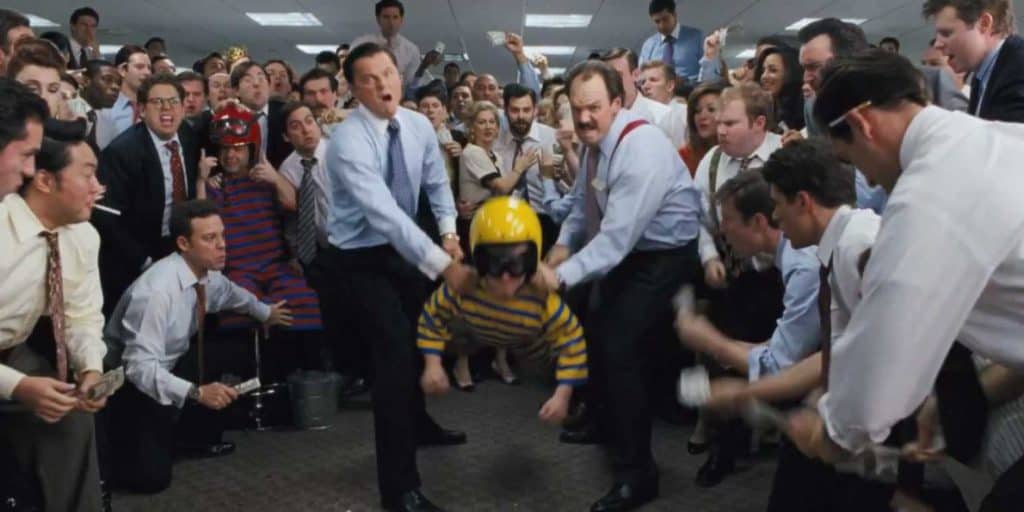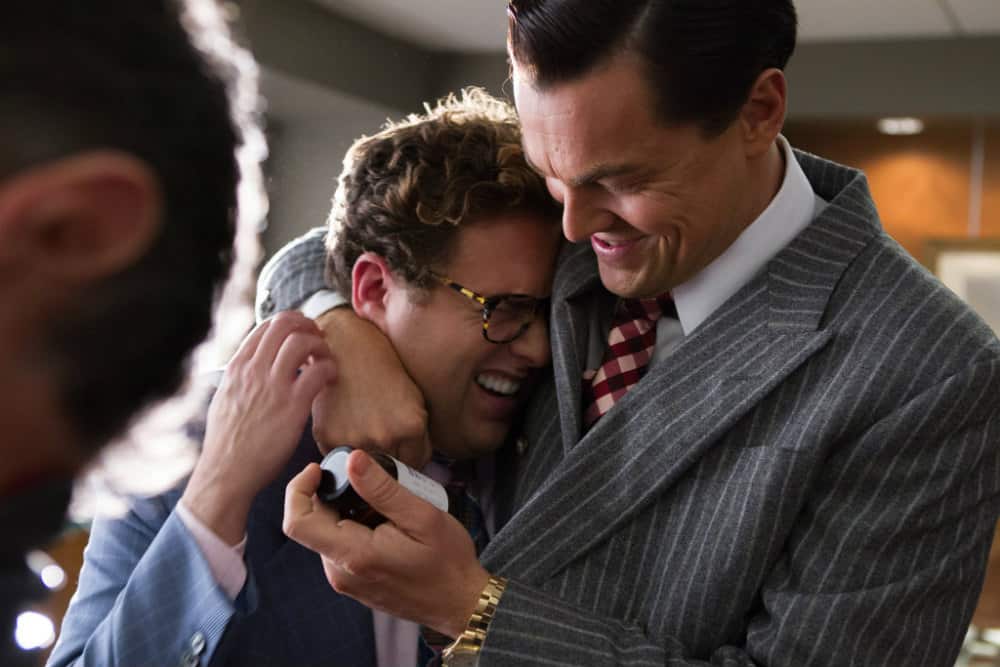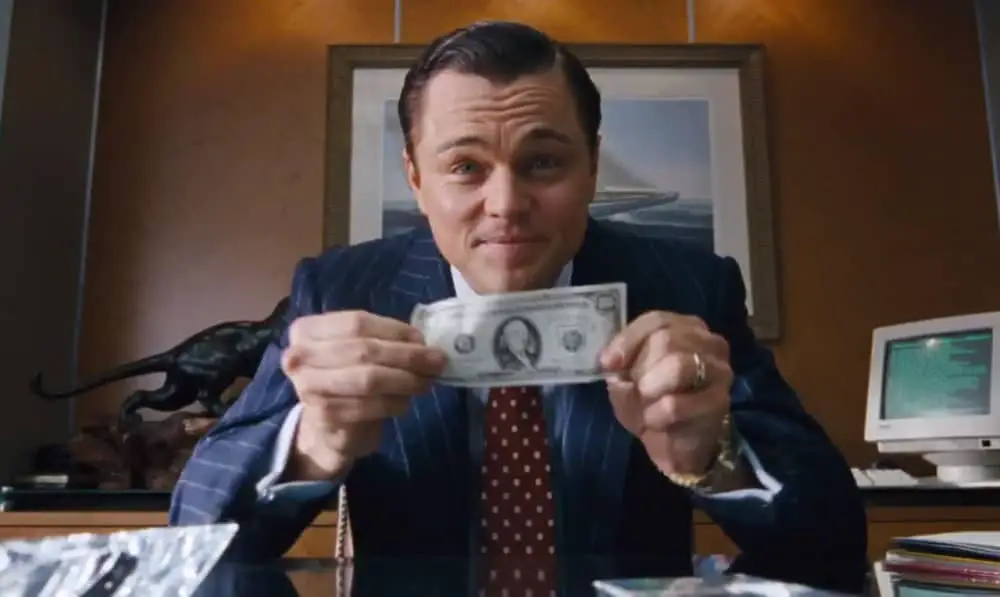The meaning of the movie “The Wolf of Wall Street”
Some critics consider it one of the best films of M. Scorsese, others are more restrained in their assessments, but both of them agree that “The Wolf of Wall Street” is an unusually juicy, talented and witty-satirical study of the values and vices of the modern world. The numerous awards received by the film and the well-deserved audience success are proof of their rightness.
However, after the release of “The Wolf of Wall Street”, some viewers argued that it was unpleasant for them to watch the adventures of such a cynical hero, even if performed brilliantly by DiCaprio. However, Jordan Belfort, the main character of the film, is not a figment of the scriptwriter’s invention and not a collective image: he is a real person who spent 22 months on prison bunks for fraud and money laundering.

Belfort in life and in cinema
The script of the film is based on the book of the same name by a once successful and unscrupulous broker, playboy and drug addict, then – a convicted criminal, and now – a motivator-speaker. It is noteworthy that the idol for Belfort during the years of his turbulent youth was not a real person, but a movie character – Gordon Gekko from the film “Wall Street”. It is unlikely that Belfort at that time suspected that he himself would become the hero of the film, but the glory, even dubious, does not bother him: as a true businessman, he managed to monetize even imprisonment, earning money from interviews and lectures.

While the shooting was going on, DiCaprio constantly consulted with the prototype of his character (the actor and the former financier continued to communicate after the filming was completed). Such a detailed approach has borne fruit: according to Belfort, the circumstances of his life in the film are reproduced quite accurately, especially the drunken scenes.
The film’s most poignant and gripping scenes, the most implausible events, took place in reality, including public cheating, fabulous enrichment and subsequent problems with the FBI. Interestingly, “The Wolf of Wall Street” is not the first film about the activities of the Stratton Oakmont company founded by Belfort: the first was the drama “Boiler Room” directed by B. Young (2000), but in terms of scope and naturalism it is far from Scorsese’s film.

Why are there so many explicit scenes in the film?
The main character of the film is not only a libertine, drug addict and swearing man: he organizes regular orgies for his subordinates, and these orgies are shown on the screen in a bright and impressive way. There are so many explicit scenes in the film that the question involuntarily arises: what is their purpose? To emphasize the immorality of Belfort, one or two episodes would be enough, especially since the repeated scenes of revelry do not add anything new to the character of the hero.
The naturalism of the film can be seen in two aspects: psychological and social. On the one hand, this is an illustration of the fact that the most powerful drug for people of a certain type is big money, which gives the illusion of omnipotence and permissiveness: after all, before the start of his scams, Belfort was not much different from those around him morally. Uncontrollable greed leads to personal degradation, but this obvious thought is not the only reason why the three-hour film in places resembles a self-instruction manual for human vices.
“The Wolf of Wall Street” is not so much a biography of a particular businessman as a brilliant mockery of the notorious consumer society and its values - the cult of pleasure and material values. At first, the unrestrained pursuit of pleasure seems not devoid of some attraction – at least for immature souls, but the further, the more obvious its meaninglessness becomes. Another woman, another dose, another orgy – and then what? Then nothing, everything goes in an endless circle, and it seems that the FBI almost did Belfort a favor by imprisoning him. Otherwise, sooner or later, a brilliant swindler would have thrown off his skates from another overdose.

Why is Belfort and his entourage acting so ridiculous after talking to the FBI?
What does a sane person do to make sure the FBI is on their tail? Immediately quits entertainment and begins to act quickly and carefully. Instead, Belfort continues to take drugs, makes a row on board a plane flying to Switzerland, harass his wife’s aunt, drives a car in a deranged state, goes on a yacht to the sea in a storm (by the way, a similar episode took place in reality), and his friends lead yourself no better.

Such behavior shows that the pursuit of pleasure inevitably conflicts with the basic instinct – the instinct of self-preservation. Involuntarily, I recall an experiment with rats, which implanted an electrode into the brain that excites the pleasure center – and the rats continuously pressed the lever that activates this electrode until they died of exhaustion.

What’s the point of selling a pen?
Since the film ends with the offer to sell the pen at Belfort’s training, it is clear that this is not just about selling technique. At one time, Jordan showed Brad how to sell a pen, creating the necessary motivation. The handle is a symbolic image, a sign of extraordinary opportunities that open up for people who know how to manipulate others and “milk” them financially. This is all that the protagonist can do, who sells to the public no longer unhelpful actions, but unhelpful trainings. However, judging by the number of people who attended the training, the desire to become a millionaire (and to consume, to consume!) Remains the main driving force of many people, and nothing threatens the cult of the dollar in the foreseeable future.

What’s the point of the movie?
A society fixated on material things and devoid of higher goals is doomed: this idea, although deeply embedded in the plot of the film, can be traced quite clearly. Both financial and political empires collapse when they forget about morality, and it is no coincidence that DiCaprio, building the image of his hero, recalled Caligula. The Roman Empire perished, of course, not from the orgies of the emperors, but the decline in morals is always and everywhere – the first bell warning of impending disasters.
But, having hit such a high note, Scorsese suddenly winks at the viewer, already tuned in to the drama. We are not in Ancient Rome: there will be no dramas, and the empire turned out to be an imaginary size.
In the postmodern world, everything is a little not serious – both crime, and punishment, and falls, and epiphanies. If the film had been set in the dramatic 1920s, Belfort’s story, like Gatsby’s, would have ended with the main character’s corpse. If it had been in the turbulent 1960s, Belfort would have sat for a long time and tediously and would have come out of prison physically broken, but morally renewed. And so Belfort is alive and well, and vice is not so terribly punished, and instead of drama – a black comedy. Is it good or not? Judge the viewer.







